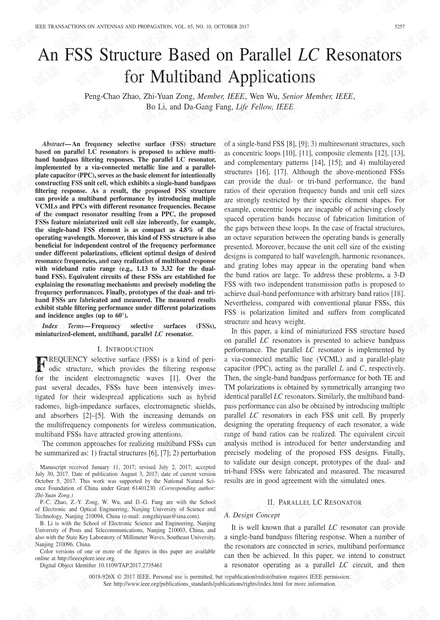
IEEE TRANSACTIONS ON ANTENNAS AND PROPAGATION, VOL. 65, NO. 10, OCTOBER 2017 5257
An FSS Structure Based on Parallel LC Resonators
for Multiband Applications
Peng-Chao Zhao, Zhi-Yuan Zong, Member, IEEE,WenWu,Senior Member, IEEE,
Bo Li, and Da-Gang Fang, Life Fellow, IEEE
Abstract—An frequency selective surface (FSS) structure
based on parallel LC resonators is proposed to achieve multi-
band bandpass filtering responses. The parallel LC resonator,
implemented by a via-connected metallic line and a parallel-
plate capacitor (PPC), serves as the basic element for intentionally
constructing FSS unit cell, which exhibits a single-band bandpass
filtering response. As a result, the proposed FSS structure
can provide a multiband performance by introducing multiple
VCMLs and PPCs with different resonance frequencies. Because
of the compact resonator resulting from a PPC, the proposed
FSSs feature miniaturized unit cell size inherently, for example,
the single-band FSS element is as compact as 4.8% of the
operating wavelength. Moreover, this kind of FSS structure is also
beneficial for independent control of the frequency performance
under different polarizations, efficient optimal design of desired
resonance frequencies, and easy realization of multiband response
with wideband ratio range (e.g., 1.13 to 3.32 for the dual-
band FSS). Equivalent circuits of these FSSs are established for
explaining the resonating mechanisms and precisely modeling the
frequency performances. Finally, prototypes of the dual- and tri-
band FSSs are fabricated and measured. The measured results
exhibit stable filtering performance under different polarizations
and incidence angles (up to 60°).
Index Terms—Frequency selective surfaces (FSSs),
miniaturized-element, multiband, parallel LC resonator.
I. INTRODUCTION
F
REQUENCY selective surface (FSS) is a kind of peri-
odic structure, which provides the filtering response
for the incident electromagnetic waves [1]. Over the
past several decades, FSSs have been intensively inves-
tigated for their widespread applications such as hybrid
radomes, high-impedance surfaces, electromagnetic shields,
and absorbers [2]–[5]. With the increasing demands on
the multifrequency components for wireless communication,
multiband FSSs have attracted growing attentions.
The common approaches for realizing multiband FSSs can
be summarized as: 1) fractal structures [6], [7]; 2) perturbation
Manuscript received January 11, 2017; revised July 2, 2017; accepted
July 30, 2017. Date of publication August 3, 2017; date of current version
October 5, 2017. This work was supported by the National Natural Sci-
ence Foundation of China under Grant 61401230. (Corresponding author:
Zhi-Yuan Zong.)
P.-C. Zhao, Z.-Y. Zong, W. Wu, and D.-G. Fang are with the School
of Electronic and Optical Engineering, Nanjing University of Science and
Technology, Nanjing 210094, China (e-mail: zongzhiyuan@sina.com).
B. Li is with the School of Electronic Science and Engineering, Nanjing
University of Posts and Telecommunications, Nanjing 210003, China, and
also with the State Key Laboratory of Millimeter Waves, Southeast University,
Nanjing 210096, China.
Color versions of one or more of the figures in this paper are available
online at http://ieeexplore.ieee.org.
Digital Object Identifier 10.1109/TAP.2017.2735461
of a single-band FSS [8], [9]; 3) multiresonant structures, such
as concentric loops [10], [11], composite elements [12], [13],
and complementary patterns [14], [15]; and 4) multilayered
structures [16], [17]. Although the above-mentioned FSSs
can provide the dual- or tri-band performance, the band
ratios of their operation frequency bands and unit cell sizes
are strongly restricted by their specific element shapes. For
example, concentric loops are incapable of achieving closely
spaced operation bands because of fabrication limitation of
the gaps between these loops. In the case of fractal structures,
an octave separation between the operating bands is generally
presented. Moreover, because the unit cell size of the existing
designs is compared to half wavelength, harmonic resonances,
and grating lobes may appear in the operating band when
the band ratios are large. To address these problems, a 3-D
FSS with two independent transmission paths is proposed to
achieve dual-band performance with arbitrary band ratios [18].
Nevertheless, compared with conventional planar FSSs, this
FSS is polarization limited and suffers from complicated
structure and heavy weight.
In this paper, a kind of miniaturized FSS structure based
on parallel LC resonators is presented to achieve bandpass
performance. The parallel LC resonator is implemented by
a via-connected metallic line (VCML) and a parallel-plate
capacitor (PPC), acting as the parallel L and C, respectively.
Then, the single-band bandpass performance for both TE and
TM polarizations is obtained by symmetrically arranging two
identical parallel LC resonators. Similarly, the multiband band-
pass performance can also be obtained by introducing multiple
parallel LC resonators in each FSS unit cell. By properly
designing the operating frequency of each resonator, a wide
range of band ratios can be realized. The equivalent circuit
analysis method is introduced for better understanding and
precisely modeling of the proposed FSS designs. Finally,
to validate our design concept, prototypes of the dual- and
tri-band FSSs were fabricated and measured. The measured
results are in good agreement with the simulated ones.
II. P
ARALLEL LC RESONATOR
A. Design Concept
It is well known that a parallel LC resonator can provide
a single-band bandpass filtering response. When a number of
the resonators are connected in series, multiband performance
can then be achieved. In this paper, we intend to construct
a resonator operating as a parallel LC circuit, and then
0018-926X © 2017 IEEE. Personal use is permitted, but republication/redistribution requires IEEE permission.
See http://www.ieee.org/publications_standards/publications/rights/index.html for more information.




 我的内容管理
展开
我的内容管理
展开
 我的资源
快来上传第一个资源
我的资源
快来上传第一个资源
 我的收益 登录查看自己的收益
我的收益 登录查看自己的收益 我的积分
登录查看自己的积分
我的积分
登录查看自己的积分
 我的C币
登录后查看C币余额
我的C币
登录后查看C币余额
 我的收藏
我的收藏  我的下载
我的下载  下载帮助
下载帮助 
 前往需求广场,查看用户热搜
前往需求广场,查看用户热搜

 信息提交成功
信息提交成功